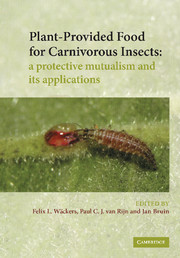Book contents
- Frontmatter
- Contents
- List of contributors
- Foreword by Peter W. Price
- 1 Food for protection: an introduction
- PART I FOOD PROVISION BY PLANTS
- PART II ARTHROPODS FEEDING ON PLANT-PROVIDED FOOD
- 5 Food needs of adult parasitoids: behavioral adaptations and consequences
- 6 Effects of plant feeding on the performance of omnivorous “predators”
- 7 Nectar- and pollen-feeding by adult herbivorous insects
- PART III PLANT-PROVIDED FOOD AND BIOLOGICAL CONTROL
- Index
- References
6 - Effects of plant feeding on the performance of omnivorous “predators”
Published online by Cambridge University Press: 15 December 2009
- Frontmatter
- Contents
- List of contributors
- Foreword by Peter W. Price
- 1 Food for protection: an introduction
- PART I FOOD PROVISION BY PLANTS
- PART II ARTHROPODS FEEDING ON PLANT-PROVIDED FOOD
- 5 Food needs of adult parasitoids: behavioral adaptations and consequences
- 6 Effects of plant feeding on the performance of omnivorous “predators”
- 7 Nectar- and pollen-feeding by adult herbivorous insects
- PART III PLANT-PROVIDED FOOD AND BIOLOGICAL CONTROL
- Index
- References
Summary
Introduction
Thousands of arthropod species consume both prey and plant food (Whitman et al. 1994; Alomar and Wiedenmann 1996; Coll and Guershon 2002). Omnivorous arthropods include species that are usually thought of as being exclusively herbivorous (e.g., grasshoppers and thrips), exclusively predaceous (e.g., ants and spiders), and species whose catholic tastes are better known (e.g., true bugs and carabid beetles). These omnivorous taxa all share the ability to utilize both prey and plant food, but differ widely in the timing and extent to which they utilize these resources, and in their morphologies, physiologies, and behaviors. Some omnivorous arthropods have been referred to as life-history omnivores (Wäckers and Van Rijn, Chapter 1). Life-history omnivores utilize prey and plant food at different stages or periods of their life (Coll and Guershon 2002; Wäckers and Van Rijn, Chapter 1). Other omnivores, however, include both prey and plant food in their diet throughout their life, although the relative importance of the two may vary with age. These species could be referred to as lifelong omnivores. Big-eyed bugs (Heteroptera: Geocoridae) are excellent examples of insects that consume prey and plant food in all life stages. We focus on the experimental studies of “predaceous” omnivores and attempt to draw conclusions regarding the effects of plant feeding on omnivorous predators and their interactions with other species.
- Type
- Chapter
- Information
- Plant-Provided Food for Carnivorous InsectsA Protective Mutualism and its Applications, pp. 148 - 177Publisher: Cambridge University PressPrint publication year: 2005
References
- 44
- Cited by

